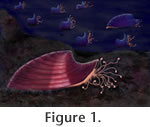|
|
|
INTRODUCTIONMolluscs occur in many of the earliest shelly assemblages and clearly began to diversify in the early Cambrian. Most of the earliest shelled molluscs were univalves with slight coiling (referred to as helcionellids) but some had shells with greater coiling (possible gastropods or their ancestors), a few others were bivalves (Pojeta 2000), and chitons might also have been present (Vendrasco et al. 2009). There is much gradation in form among these early molluscs, and hence different possible transitional sequences in the fossil record have been identified from helcionellids to rostroconchs, bivalves, scaphopods, gastropods, and cephalopods (e.g., Runnegar and Pojeta 1974, Pojeta and Runnegar 1976, Kouchinsky 1999). These evolutionary scenarios and the relationships among the earliest molluscs remain controversial, however, because there are so few characters that are well known from their fossil shells. Further complicating the issue is that at least some helcionellids appear to represent the larval shell of an adult form that looks somewhat different (Martí Mus et al. 2008). Pioneering work by Runnegar (1985) revealed that phosphatic shell moulds and replacements of Cambrian molluscs preserve details of their shell microstructure in sub-micrometer detail. Runnegar showed that secondary calcium phosphate coatings on the inner shell surface – probably precipitated as a result of bacterial decay shortly after the death of the animal (Lucas and Prévôt 1991) – could preserve imprints of shell microstructures in both inner and outer shell layers. Runnegar (1985) documented that some of the more common varieties of shell microstructure in modern molluscs (e.g., crossed lamellar, prismatic, foliated calcite) also occurred in Cambrian forms. Shell microstructure is rarely preserved in early Palaeozoic fossils, and so Runnegar's work revealed a new suite of characters that could be used to better understand the degree of diversification, phylogeny, and shell strength of the early molluscs. More recent observations (Kouchinsky 1999, Vendrasco et al. 2010) indicate that shell microstructures have a strong phylogenetic signal and hence can help in assessing hypotheses of relationships and transitions among early molluscs. The rapid diversification of animals beginning around 542 million years ago was one of the most significant events in the history of life. This event, known as the "Cambrian Explosion," is characterized by the independent appearance and rapid diversification of shells in many animal lineages (Bengtson and Conway Morris 1992). Although there have been significant advances over the past few decades in our understanding of this interval, we are far from knowing the causes of the event. One of the more prominent hypotheses about the Cambrian explosion is that it was caused by the onset of predation, which likely drove adaptation in various lineages toward diverse defensive solutions. Information about early predators and the response of their prey is rather limited, but a number of observations suggest predation was a strong selective pressure in the Cambrian: (1) the earliest signs of predation occur at the base of the Cambrian or just before (Bengtson and Zhao 1992); (2) many different types of fossil evidence of predation have been recovered from Cambrian rocks, including predatory appendages on fossil arthropods (Whittington and Briggs 1985), drill holes (Conway Morris and Bengtson 1994), bite marks (Conway Morris 1998), ingested prey preserved in the digestive tract of predators (Whittington 1985), and healed shell scars (Skovsted et al. 2007); and (3) shells, thought by many to be primarily a tool of defense (Vermeij 1987), appeared in many different animal lineages during the Cambrian explosion (Bengtson and Conway Morris 1992) and were made of diverse components and with different microstructures (Bengtson and Conway Morris 1992), and so likely evolved independently in many clades. Nevertheless, in spite of this preliminary support, the hypothesis that predation was a major driving force of the Cambrian explosion is still disputed. Mellopegma Runnegar and Jell, 1976 is a stenothecid found in Cambrian deposits worldwide (Table 1). Stenothecids are helcionellid molluscs with significant lateral compression (Runnegar and Jell 1980). They also have a curved ventral margin, as do bivalves and rostroconchs, the latter an extinct class of molluscs with a univalved larval shell and bivalved but inflexible adult shell (Pojeta 1987). In part because stenothecids have a shell form intermediate between typical helcionellids and the two bivalved mollusc classes, they – in particular Mellopegma – were considered possible ancestors of bivalves and/or rostroconchs (Runnegar and Jell, 1976; Runnegar 1978, 1996; Pojeta 1978).
|
|
